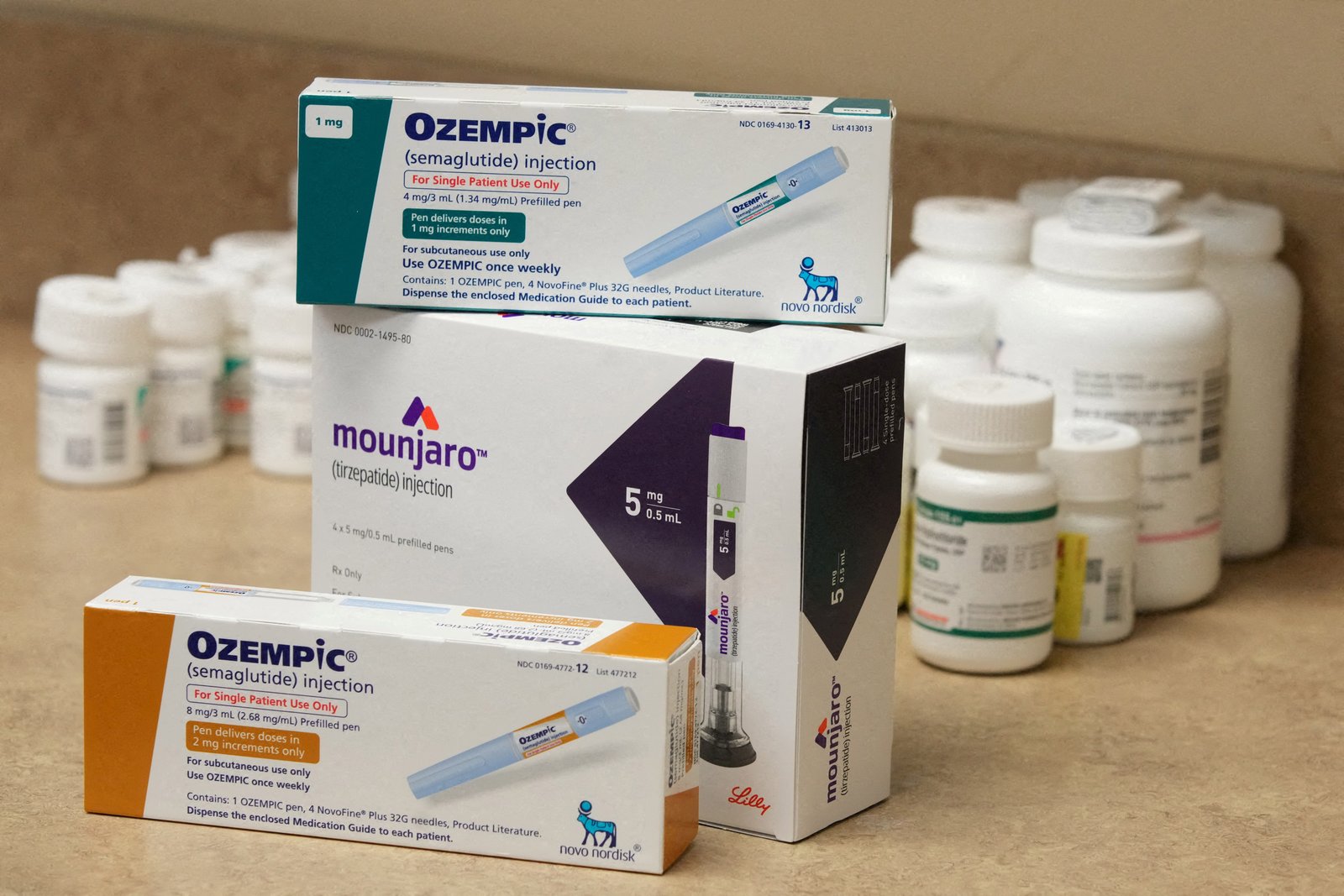Type 2 Diabetes Treatment and Weight Management
Ozempic (semaglutide)
Ozempic is a medication used to manage blood sugar levels in individuals with type 2 diabetes. It is a GLP-1 receptor agonist that helps to increase insulin production, reduce blood sugar levels, and support weight loss. Depending on individual needs and conditions, Ozempic can significantly improve diabetes management and overall health. Treatment with Ozempic should be part of a comprehensive diabetes care plan, which includes diet, exercise, and regular blood sugar monitoring.
Ozempic Usage, Benefits, and Clinical Insights
Introduction
Semaglutide (Ozempic®) is a medication that has garnered significant attention for its dual effectiveness in treating type 2 diabetes and promoting weight loss. Developed by Novo Nordisk, Semaglutide belongs to the class of drugs known as GLP-1 receptor agonists. These drugs mimic the action of the hormone GLP-1 (glucagon-like peptide-1), which plays a critical role in regulating blood sugar and controlling appetite.
Overview of Semaglutide (Ozempic®)
Semaglutide (Ozempic®) is specifically designed to improve blood sugar control in adults with type 2 diabetes. Additionally, it is often prescribed off-label to aid in weight loss due to its demonstrated efficacy in promoting significant weight reduction. Understanding the comprehensive nature of this medication, including its development, FDA approval, mechanism of action, benefits, administration, side effects, storage, cost, and supporting clinical studies, is essential for prospective users.
Development and FDA Approval
Semaglutide was developed by Novo Nordisk, a pharmaceutical company with a strong track record in diabetes care. It was approved by the U.S. Food and Drug Administration (FDA) in December 2017 for the treatment of type 2 diabetes. The approval was based on extensive clinical trials that demonstrated the medication's efficacy and safety in managing blood sugar levels and contributing to weight loss.
Mechanism of Action
Understanding how Semaglutide works is crucial to appreciating its benefits. As a GLP-1 receptor agonist, Semaglutide mimics the action of the natural hormone GLP-1. This hormone helps to increase insulin production in response to meals, decrease the release of glucagon (a hormone that raises blood sugar), and slow gastric emptying, which prolongs the feeling of fullness. These combined actions help lower blood sugar levels and aid in weight management by reducing appetite.
Benefits of Using Semaglutide
Semaglutide offers several significant benefits, making it a valuable option for many people with type 2 diabetes. These benefits include:
Blood Sugar Control: Semaglutide helps manage blood sugar levels by increasing insulin secretion and reducing glucagon release. This leads to improved HbA1c levels, a key marker of long-term blood sugar control.
Weight Loss: Many patients experience substantial weight loss while using Semaglutide. Clinical trials have shown that patients can lose an average of 5-10% of their body weight over a year, with some losing even more.
Cardiovascular Benefits: Semaglutide has been shown to reduce the risk of major cardiovascular events, such as heart attacks and strokes, making it a beneficial treatment option for patients with type 2 diabetes who are at higher risk for heart disease.
Administering Semaglutide
Correct administration of Semaglutide is crucial for its effectiveness. It is administered via a subcutaneous injection (under the skin) once a week. The medication comes in a pre-filled pen that makes it easy to inject. Common injection sites include the abdomen, thigh, or upper arm. Patients are advised to rotate injection sites to avoid skin irritation.
Injection Technique and Dosage Schedule
Following proper injection techniques and adhering to the dosage schedule are essential. Patients should be trained by their healthcare provider on how to use the injection pen. Typically, the initial dose is 0.25 mg once weekly for four weeks, followed by an increase to 0.5 mg once weekly. If additional glycemic control is needed, the dose may be further increased to 1 mg once weekly.
Side Effects of Semaglutide
While Semaglutide has many benefits, it is also important to be aware of potential side effects. These can be categorized into common and serious side effects.
Common Side Effects: Gastrointestinal issues are the most common side effects and include nausea, vomiting, diarrhea, abdominal pain, and constipation. These symptoms are usually mild to moderate and tend to decrease over time as the body adjusts to the medication.
Serious Side Effects: Although rare, serious side effects can occur, such as pancreatitis (inflammation of the pancreas) and an increased risk of thyroid tumors. Patients should be monitored for these conditions, especially if they have a history of pancreatic or thyroid diseases.
Who Should Not Use Semaglutide?
Certain individuals should avoid using Semaglutide. These include:
Individuals with a history of medullary thyroid carcinoma (MTC) or those with Multiple Endocrine Neoplasia syndrome type 2 (MEN 2).
Pregnant or breastfeeding women.
Children and adolescents under 18 years of age.
Individuals with a known hypersensitivity to Semaglutide or any of its components.
Storage and Handling of Semaglutide
Proper storage and handling are essential to maintain the medication’s effectiveness. Unused Semaglutide pens should be stored in the refrigerator at temperatures between 36°F to 46°F (2°C to 8°C). Once in use, the pens can be kept at room temperature (up to 86°F or 30°C) for a specified period, typically 56 days. It is important to keep the medication away from direct sunlight and heat and to dispose of used needles in a sharps container.
Cost of Semaglutide
The cost of Semaglutide can be a significant factor for many patients. Without insurance, the price for a one-month supply can range from $800 to $1,000. Insurance coverage can significantly reduce out-of-pocket costs, and many insurance plans include Semaglutide in their formularies. Novo Nordisk offers a co-pay savings card for eligible patients, which can lower monthly co-pays to as little as $25 to $50. Patients should check with their insurance providers and explore available assistance programs to manage the cost of treatment.
Clinical Studies Supporting Semaglutide
Clinical studies are vital in validating the efficacy and safety of Semaglutide. The SUSTAIN program, a series of clinical trials, has been instrumental in demonstrating the benefits of Semaglutide.
SUSTAIN-1: This trial showed significant reductions in HbA1c levels and weight loss in patients who were not previously treated with any diabetes medication.
SUSTAIN-2 to SUSTAIN-6: These trials included patients already on other diabetes medications. Adding Semaglutide to their treatment regimen resulted in further improvements in blood sugar control and weight loss.
SUSTAIN-7: This study compared Semaglutide with Dulaglutide, another GLP-1 receptor agonist. Semaglutide was found to be more effective in lowering HbA1c levels and promoting weight loss.
Conclusion
Semaglutide (Ozempic®) is a valuable medication for managing type 2 diabetes and aiding in weight loss. Its benefits include improved blood sugar control, significant weight loss, and cardiovascular protection. Proper administration, awareness of potential side effects, and understanding the cost are crucial for effective use. Clinical studies support its efficacy and safety, making Semaglutide a compelling option for many patients. Consulting with a healthcare provider is essential to determine if Semaglutide is the right choice for an individual's health needs.
Sources
| Reference | Details |
|---|---|
| Marso, S. P., Bain, S. C., Consoli, A., et al. | Semaglutide and Cardiovascular Outcomes in Patients with Type 2 Diabetes. New England Journal of Medicine, 375(19), 1834-1844. |
| Davies, M. J., D’Alessio, D. A., Fradkin, J., et al. | Management of Hyperglycemia in Type 2 Diabetes, 2018. A Consensus Report by the American Diabetes Association (ADA) and the European Association for the Study of Diabetes (EASD). Diabetes Care, 41(12), 2669-2701. |
| Wilding, J. P. H., Batterham, R. L., Calanna, S., et al. | Once-Weekly Semaglutide in Adults with Overweight or Obesity. New England Journal of Medicine, 384(11), 989-1002. |
Frequently Asked Questions
No, we do not sell medication directly. We offer a variety of solutions via our partners. You'll be taken to their store directly when you purchase.
Additional information
















